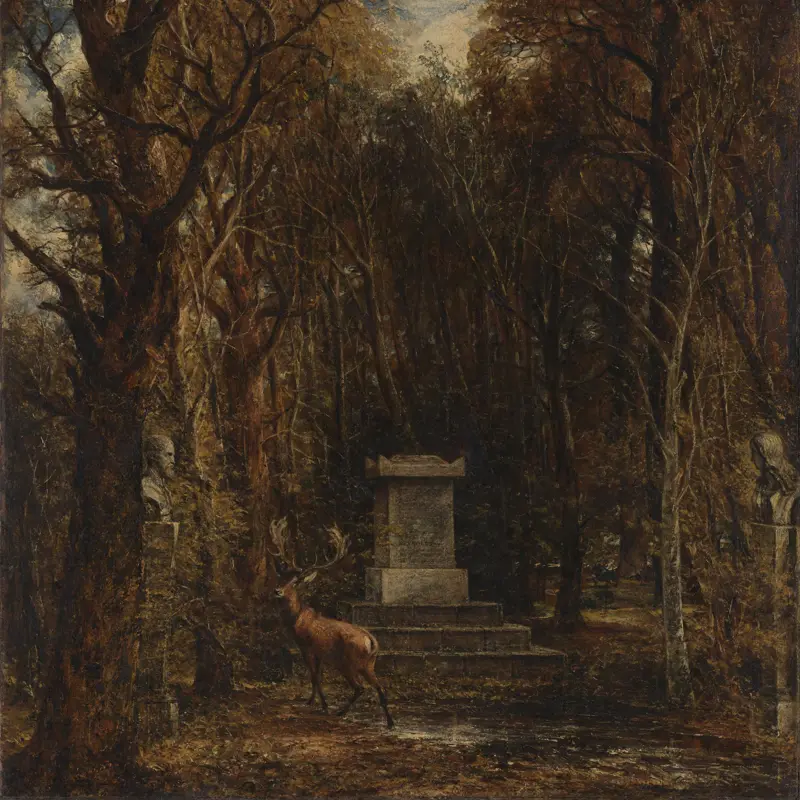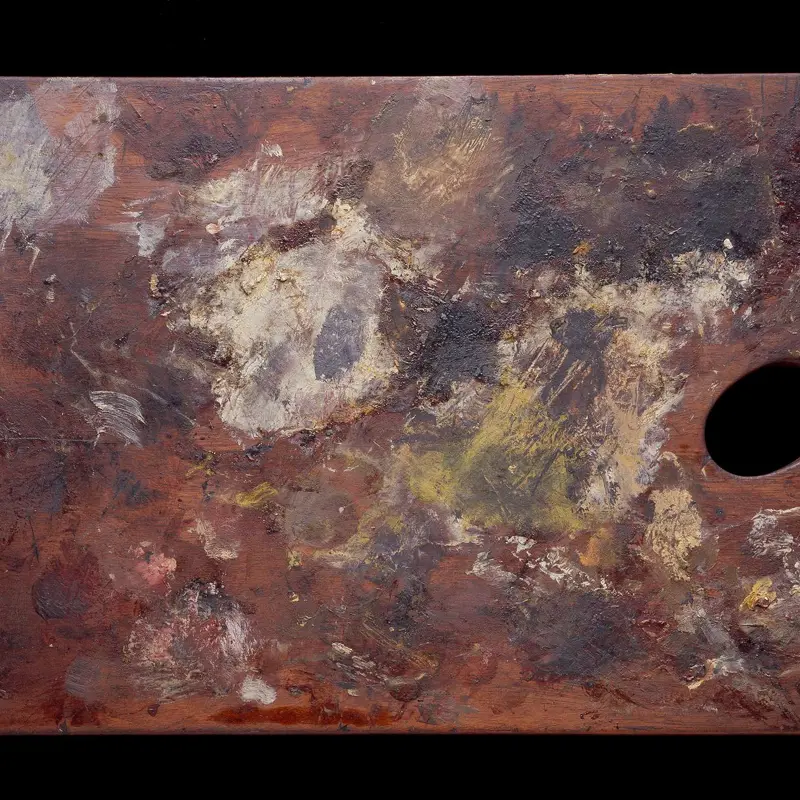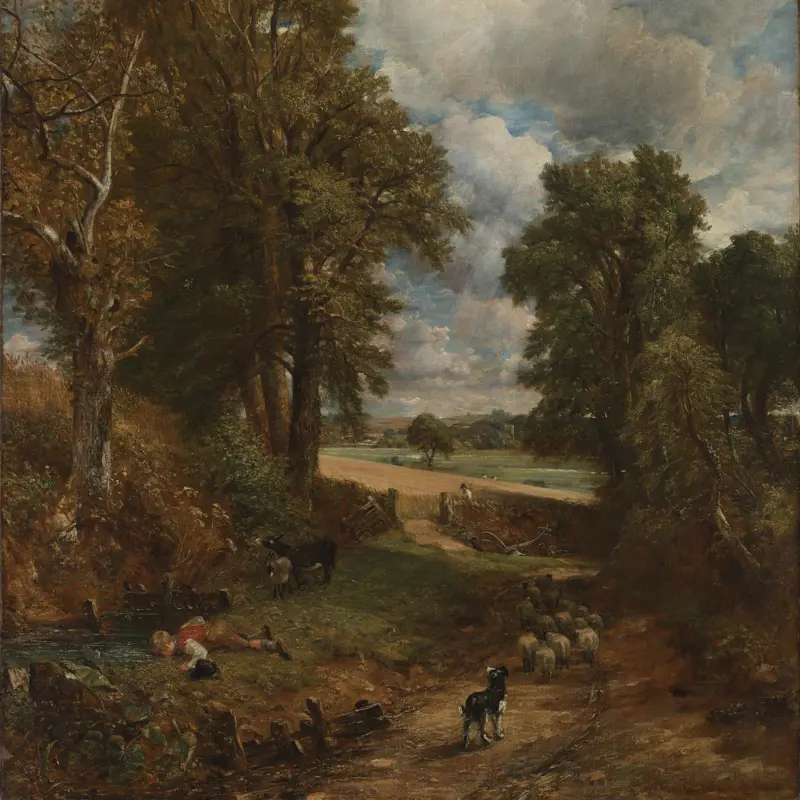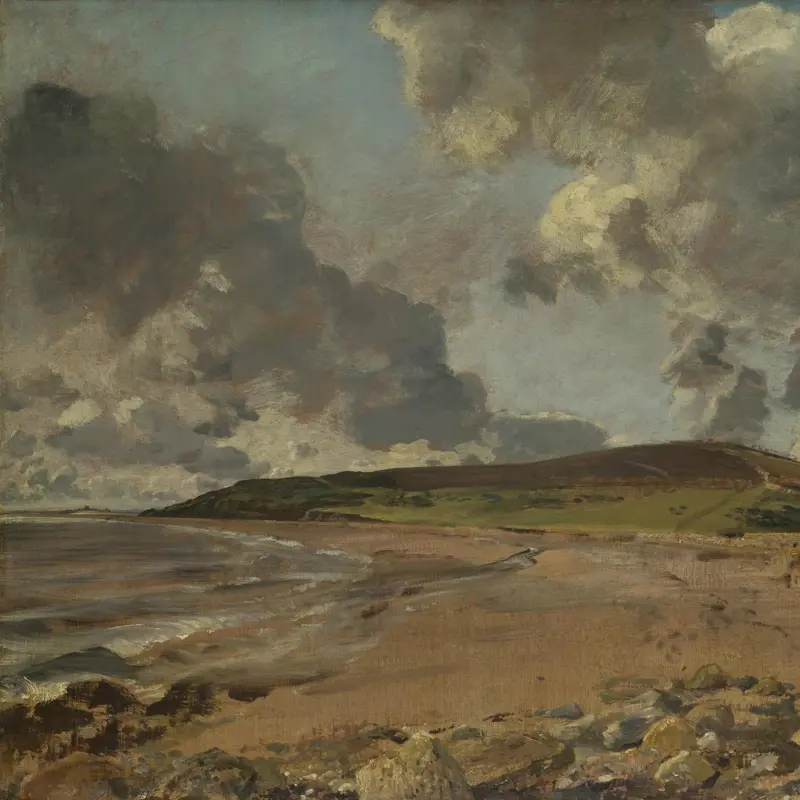John Constable, 'The Hay Wain', 1821
About the work
Overview
The view is of the millpond at Flatford on the River Stour. Flatford Mill was a watermill for grinding corn, operated by the Constable family for nearly a hundred years. It still survives and is about a mile from Constable’s birthplace at East Bergholt, Suffolk. The house on the left also survives; in Constable’s time it was occupied by tenant farmer Willy Lott.
The title, The Hay Wain, refers to the wooden wagon (wain) used for transporting cut and dried meadow grass (hay). The empty wagon is making its way through the shallow water to cross to the meadow on the other side where haymakers are at work.
Although the painting evokes a Suffolk scene, it was created in the artist’s studio in London. Working from a number of open-air sketches made over several years, Constable then made a full-size preparatory oil sketch to establish the composition before painting the final picture.
Audio description
Listen to an audio description of Constable’s 'The Hay Wain'
Transcript
This is a description of an oil painting called ‘The Hay Wain’ by the British artist John Constable. It is a large painting – just over a metre high and two wide - it was painted and first exhibited in 1821. It depicts an idyllic rural scene of a hay cart crossing a tree-lined river running through the English countryside. This sun-dappled farming scene projects a mood of tranquillity and contentment; a mood quite at odds with the lived experience of many agricultural workers at this time. The image depicts a millpond on the River Stour at Flatford on the border between Essex and Suffolk. The dark, shallow river idles slowly along the lower third of the painting. It curves away, to the far left, passing a picturesque farmhouse. The warm sun gives the triangular gable of its white walls and red roof tiles a soft golden glow. One of its lead- lined windows is pushed open, cooling the house on this warm summers' day A woman on a wooden platform, which juts out from the side of the house into the river, kneels with a jug to collect water. To reach the river for a paddle, it would be necessary to take a few steps across the sandy silt of the riverbank in the foreground. Standing here on the sweeping curve of the river bank is a fluffy black and white farm dog, looking out attentively at the hay cart, or ‘hay wain’, as it crosses. The wooden slatted cart is empty. It is being pulled away from us by three sturdy black horses, heading across the water They are directed
by two workmen in white shirts, wearing hats. One holds a whip, while the other raises one arm in the direction of a gap in the low foliage along the far-river bank. The Hay Wain is probably headed towards this spot to ford the river, heading to pick up the hay being harvested in the sun-kissed meadow beyond. Here the field is bordered by distant trees and peopled by small white shapes indicating the presence of labourers, stooped over harvesting the hay, the midday sun glinting off of the shirts on their backs. The heavy work collars of the horses are brightly decorated with red fringing, contrasting with the greens of the trees and reeds lining the riverbank. On the left of the painting, on the far riverbank, there is a row of broad, mature trees casting shade. Above the trees the upper third of the painting is filled with billowing clouds, darkening in places, with small patches of blue sky showing through. To the far right of the canvas, the riverbank gives way to a dense thicket where a small wooden rowing boat is moored. Appearing through the reeds, pushing his way to the boat, is a man in a black hat with a fishing rod. At the extreme right edge of the painting there is a red pillar, the only indication of the nearby Flatford Mill which had been operated by the Constable family for nearly 100 years. This was country that Constable knew well from his boyhood, the mill being a
mile from his birthplace at East Bergholt. Many aspects of this painting were revolutionary at the time. Constable was an exception in advocating sketching outdoors. There is a sense of freshness and closely observed nature in this painting – ducks dabble in the river as swifts swoop low across its surface to pick off the flies. Constable uses tiny dabs of white paint to capture the effect of sunlight flickering on fluttering leaves – his critics called it ‘Constable’s snow’. This shocked his contemporaries who were used to the blended brushwork, brown tones and smooth surfaces of traditional landscapes. Constable’s keen observation of nature is also apparent in the accuracy of his skies. Here he captures the vastness of a changeable Suffolk summer sky with one ominous raincloud. Although the painting evokes a Suffolk scene, it was in fact created in Constable’s studio in London. Working from open-air sketches made over several years, It was painted at a time of civil unrest and agrarian riots. Constable’s determination to capture the idealised rural Suffolk landscape of his boyhood, must in part have been due to a sense that rural life was changing due to rapid industrialisation and the pushback by workers against the economic and social disparity growing in the country. Constable did not call this picture, ‘The Hay Wain’ – it was a nickname
given to it by his friend Archdeacon Fisher. When it was sent to the Royal Academy in 1821 with its given title ‘Landscape: Noon‘, it was greeted favourably by reviewers who declared it “approaches nearer to the actual look of rural nature than any modern landscape whatever”. It didn’t sell in Britain so Constable reluctantly sold it to a French art dealer who exhibited the painting in Paris . There it caused a sensation, won Constable a gold medal from the French king, and would serve to inspire a new generation of French artists to paint directly from nature.
Key facts
Details
- Full title
- The Hay Wain
- Artist
- John Constable
- Artist dates
- 1776 - 1837
- Date made
- 1821
- Medium and support
- Oil on canvas
- Dimensions
- 130.2 × 185.4 cm
- Inscription summary
- Signed; Dated
- Acquisition credit
- Presented by Henry Vaughan, 1886
- Inventory number
- NG1207
- Location
- Room 40
- Collection
- Main Collection
- Previous owners
- Frame
- 19th-century English Frame (original frame)
Provenance
Additional information
Text extracted from the ‘Provenance’ section of the catalogue entry in Judy Egerton, ‘National Gallery Catalogues: The British Paintings’, London 2000; for further information, see the full catalogue entry.
Exhibition history
-
2014John Constable: The Making of a MasterVictoria and Albert Museum20 September 2014 - 11 January 2015
-
2024National TreasuresBristol City Museum and Art Gallery10 May 2024 - 1 September 2024
-
2024Discover Constable and The Hay WainThe National Gallery (London)17 October 2024 - 2 February 2025
Bibliography
-
1841H. Artaria, A Descriptive Catalogue of the Gallery of Pictures Collected by Edmund Higginson, London 1841
-
1846Christie & Manson, Catalogue of the Very Important Collection of Pictures, the Property of Edmund Higginson Esq. of Saltmarshe, Herefordshire, London, 4 June 1846 - 6 June 1846
-
1927H. Focillon, La peinture au XIXe siècle: Le retour de l'antique, le romantisme, Paris 1927
-
1933H.I. Kay, 'The Hay Wain', The Burlington Magazine, LXII/363, 1933, pp. 281-9
-
1934R.N.D. Wilson, The National and Tate Galleries, London 1934
-
1946Davies, Martin, National Gallery Catalogues: British School, London 1946
-
1946M. Davies, Paintings and Drawings on the Backs of National Gallery Pictures, London 1946
-
1949A. Malraux, Psychologie de l'art, Paris 1949
-
1956R. Beckett, 'Constable and France', The Connoisseur, CXXXVII, 1956, pp. 249-55
-
1957M. Florisoone, 'Constable and the "Massacres de Scio" by Delacroix', Journal of the Warburg and Courtauld Institutes, XX/1-2, 1957, pp. 180-5
-
1959Davies, Martin, National Gallery Catalogues: British School, 2nd edn (revised), London 1959
-
1960G. Reynolds, Catalogue of the Constable Collection, London 1960
-
1976L. Parris, I. Fleming-Williams and C. Shields, Constable: Paintings, Watercolours and Drawings, London 1976
-
1976A. Smart and A. Brooks, Constable and His Country, London 1976
-
1976L. Parris, I. Fleming-Williams and C. Shields, Constable: Paintings, Watercolours and Drawings (exh. cat. Tate Gallery, 18 February - 23 April 1976), London 1976
-
1980J. Barrell, The Dark Side of the Landscape, Cambridge 1980
-
1981M. Pointon, Romanticism in English Art, London 1981
-
1982R. Paulson, Literary Landscape: Turner and Constable, New Haven 1982
-
1983M. Rosenthal, Constable: The Painter and His Landscape, New Haven 1983
-
1986M. Cormack, Constable, Oxford 1986
-
1987A. Bermingham, Landscape and Ideology: The English Rustic Tradition, 1740-1867, London 1987
-
1989E. Helsinger, 'Constable: The Making of a National Painter', Critical Enquiry, XV/1, 1989, pp. 253-79
-
1991L. Parris and I. Fleming-Williams, Constable, (exh. cat. Tate Gallery, 13 June - 15 September 1991), London 1991
-
1992A. Hemingway, Landscape Imagery and Urban Culture in Early Nineteenth-Century Britain, Cambridge 1992
-
1993F.F. Frascina et al., Modernity and Modernism: French Painting in the Nineteenth Century, New Haven 1993
-
1994E. Le Roy Ladurie, Paysages, paysans (exh. cat. Galerie Mazarine, 25 March - 26 June 1994), Paris 1994
-
1995P. Bishop, An Archetypal Constable: National Identity and the Geography of Nostalgia, London 1995
-
1998J. Egerton, The British School, London 1998
-
1999J.E. Thornes, John Constable's Skies: A Fusion of Art and Science, Birmingham 1999
-
2000Egerton, Judy, National Gallery Catalogues: The British Paintings, revised edn, London 2000
-
2000N. MacGregor, 'Chef-d'oeuvre: Valeur sûre?', in H. Belting et al., Qu'est-ce qu'un chef-d'oeuvre?, Paris 2000, pp. 67-104
-
2001
C. Baker and T. Henry, The National Gallery: Complete Illustrated Catalogue, London 2001
-
2002W. Vaughan, John Constable, London 2002
-
2002J. Padfield et al., 'Improvements in the Acquisition and Processing of X-Ray Images of Paintings', National Gallery Technical Bulletin, XXIII, 2002, pp. 70-1
-
2003P. Noon et al., Constable to Delacroix: British Art and the French Romantics (exh. cat., Tate Britain, 5 February - 11 March 2003; The Minneapolis Institute of Arts, 8 June - 7 September 2003; Metropolitan Museum of Art, 7 October - 4 January 2004), London 2003
-
2005R. Lambert, John Constable and the Theory of Landscape Painting, Cambridge 2005
-
2006M. Rosenthal, 'Constable and Englishness', British Art Journal, VII/3, 2006, pp. 40-5
-
2006A. Lyles, Constable: The Great Landscapes (exh. cat. Tate Britain, 1 June - 28 August 2006), London 2006
-
2007P. McEvansoneya, 'John Constable and the Royal Hibernian Academy in 1834, with an Unpublished Letter to Martin Cregan', The Burlington Magazine, CXLIX, 2007, pp. 685-9
-
2007T. Wilcox, 'Not "The Hay Wain"? Constable's "Landscape, Noon" and Its Many Titles', British Art Journal, VIII/2, 2007, pp. 16-23
Frame
This English pinewood frame was made between 1831 and 1854 by the framemaker T. Fielder (the back of the frame bears the trade label, from 3 Greek Street, London). Crafted from moulded composition, the frame is oil-gilded. The centre and corner cartouches feature shell and leaf motifs, slightly protruding over the top half-round moulding. The main section of the ogee moulding is adorned with delicate C-scrolls, scrolling leaves and small flower heads, all arranged in a repeating pattern on a diaper ground. The front moulding is modern and was added when the frame was fitted with a glazing door.
By 1927 the National Gallery had acquired the gold medal awarded to Constable by the French King Charles X at the Salon of 1824, and copies of the obverse and reverse were inserted into the frame’s mouldings. These copies were later removed, and for the bicentenary celebrations of the National Gallery in 2024, two casts of the medal were reinstated.
About this record
If you know more about this work or have spotted an error, please contact us. Please note that exhibition histories are listed from 2009 onwards. Bibliographies may not be complete; more comprehensive information is available in the National Gallery Library.







